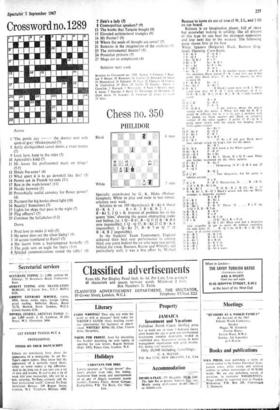Chess no. 350
PHILIDOR
Specially contributed by G. K. Hicks (Wolver- hampton). White to play and mate in two moves; solution next week.
Solution to no. 349 (Bartolovic): R - Kt 4, threat
Q-K 4. I . . B x R; 2 R-K B 2. 1 ... B- Kt 2; 2 Q x R. Interest of problem lies in the queen 'tries,' showing the queen obstructing rooks and bishop, i.e. 1 Q -B 6?, R -Q 11 (2 R -K B 6 now impossible); 1 Q- Q 5?, B- Kt 2! (2 B-K 6 impossible); 1 Q- Kt 2?, B- B 7 or Q 7! (2 R -K B 2 impossible).
In the Students' Team Tournament, England achieved their best ever performance in coming third, one point behind the us who were two points behind the USSR. Basman, Keene and Whiteley did particularly well; it was a fine effort by Michael Basman to score six out of nine (5 W, 2 L, and 2 EX on top board. Basman is an imaginative player, full of ideas but somewhat lacking in solidity; like all players of this type he can beat the strongest opponents and lose next day to the weakest. The following game shows him at his best.
White, Spassov (Bulgaria). Black, Basman (Eng- land). Opening, Caro-Kann.
1 P - K 4 P - Q B 3 2 P -0 4 P - Q 4
3 Kt - Q.B 3 P X P
4 Kt X P Kt - K El 3 c Kt x Kt Kt P x Kt
6 P - QB 3 B - B 4
7 Kt - K 2 P - K R 4. In another recent example of
this variation Black played P - K 3 and later got a bad game; here Black delays P - K 3—for reason, sec note to move 10.
8 P-K R4 Kt-C.)2
v Kt-Kt 3 B - Kt 5
10 B - K 2 . . If Black's pawn were on K 3, White could now play 10 P - B 3 with advantage; as it is. 10 P - B 3, Q - B 2; II K - B 2, B - K 3 leads nowhere useful.
10 . . . B x B 1 l Q x 13 Q- R 4 t2 0 - 0 0 - 0 - 0 13 P - Q R 4 . . . I am dubious about the attack
started with this move; if White will had his K B it would be different but as it is he gets a position with his pawns on black squares and Black in complete control of the white squares. I prefer 13 P - Q B 4 going more slowly with the attack but keeping some white square control.
13 . . . Kt-Kt 3 14 P - Kt 4 Q - Q 4 15 P - Kt 5 P - K 3 16 P X P QxSP 17 P - It 5 . . . 17 Kt x P will give Black more than enough attack on king's side for the pawn. 17 . . . Kt - B 5 18 B -13 4 R - Q 4. Look at the White squares!
19 Kt -K 4 P - K 41 20 Kt Q 2 Kt Kt
21 B x Kt R - Kt 1. Threat R X Q P—now White
gets further weakened on the white squares. 22 P - Kt 3 R - Kt 5 23 /3 - K 3 . . . Threatening 24 P - Q B 4 and 25 P - Q 5 23. . R - Q 2
24 P X. P? . . . Too dangerous, but his game is
inferior anyway.
24 . P x P
25 ii X P P- B 3! Threatening 26 . . . R X R P;
27 P X R, R - Kt 2 ch. 26 K R - Kt 1 . . . If 26 K - R 2. R (2) - Kt 2; 27 R - K Kt 1, B - Q 3 Black's attack will win—so White attempts a desperate counter. 26 . . . RxRP 27 P - B 3 R -Kt 2
28 B -,11 2 B - B 4
29 K -Kt 2 P - K 5! Threat 30 . . , . P X P 'cis; 1 Q x P, R - R 7 eh.
30 R -R 1 R - B 5
31 K -R 2 P X P 32 Q--13 1 R - R 5 eh
33 P X R. . 33 K- Kt 1. R x P eh 33 . . . Q.- Q 3 ch7 Black now had a desperate time scramble to get to move 40 without exceeding the time limit; 33 . . . B - Q 3 ch; 34 K - R 3, Q - Q 2 mate, is of course correct.
34 K - R 3 Q - K 3 ch 35 K - R 2 B- Q 3 ch 36 B - Kt 3 B X B ch 17 K - Kt 1 B - K 8 ch 38 K - R 2 Q - K 4 ch 39 K- R 3 Q- Kt 6 mate.






























 Previous page
Previous page